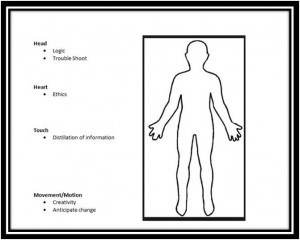Building an IT Career Ready Washington: 2015 and Beyond: Introduction
The Ideal IT Student
Introduction: In considering what transforms someone who has even a mild curiosity about pursuing an academic and career pathway in IT, one of the primary questions is, what are the critical components that can produce an ideal IT
- student,
- graduate,
- job candidate, and finally,
- worker?
Is there a formula to this composition? What are the essential elements that might be distilled into a general guideline that informs IT educators and students when building and refining an IT Program of Study? Can an actionable plan and series of steps build something concrete that better prepares the IT student? Questions were developed for a team of IT professionals to extract a list of ingredients for IT educators and students to reflect upon as they start their next academic year.
This report, Building an IT-Ready Washington: 2015 and Beyond, outlines the in-demand technical skills and knowledge, including employability skills, IT students should become familiar with. All of these skills, in some combination, are required qualifications for the majority of IT employers. The information, resources, and expansion on what these technical knowledge and skills are, and why they are important, increases the probability the IT student will be prepared to meet their future employer’s job requirements and responsibilities. This report also showcases and details a compilation of standards for IT students and educators that create clearer expectations of what an IT program should be offering in terms of curricular content. Essentially, these highly desirable attributes, as identified by a team of IT professionals, should have been absorbed into the student’s lexicon upon graduation.
This report’s intention is to act as a resource guide which IT educators can use to transform their IT students into an IT ideal graduate and future worker. Throughout, IT educators can evaluate the information and consider alignment of the ideal IT student attributes in their classrooms, curriculum, project-, and work-based learning assignments.
The Center of Excellence for Information and Computing Technology, hosted at Bellevue College, asked a team IT professionals’ five questions. These professionals provided a large amount of information for the Center to study, research, and expand upon. The team of professionals was selected as their jobs cover IT occupations in networking, systems design and administration, programming, big data and mining analytics, web design and development, and game development and design. The assembled team was comprised of the following:
- Jonny Chambers, Microsoft
- Lisa Edwards, Boeing
- Valerie Goulds, Microsoft
- Rich James, F5 Networks
- Ski Kacoroski, Northshore School District
- Katie Metcalf, Microsoft
- Chris Orth, Well Played Games
- Juan Ulloa, EagleView Technologies
The questions they answered were:
- If you had advice for an IT graduate (irrespective of whether they earned a 2- or 4- year degree), who is about to enter the workforce…What are the top five IT courses (and subsequent IT concepts/competencies) they should have mastered? (For example, networking, programming, database design/development, etc.)
- What new technology competencies should the IT graduate be anticipating and searching out to master either in college, a training program, opportunities provided online, or by self-mastery (reading a book, or IT content-specific website)?
- Often, IT employers bemoan the lack of innovation and critical thinking in an IT graduate. Why do you think that is? What could the student do to “grow” their own capacity to innovate and think critically?
- When you are training and/or mentoring a new IT employee, what three things do you spend the most time on with them to improve their performance?
- In this diagram we have the outline of the ideal IT graduate/job candidate (refer to handout). Attach adjectives, descriptors, specific things that quantify and define this “ideal” under the headings head, heart, touch, movement/motion (skills, knowledge, intangible and concrete qualities, personality traits, characteristic, etc. – a few examples have been given). Note: Please use this in the context of your IT expertise/specialization (i.e. web, programming, gaming, etc.).
The Center compiled the IT professional’s answers, and then organized the responses, and performed the following:
- Curated the results to ensure consistency and clarity
- Refined their responses and the information provided through research in order to concretely defining and creating context
- Mined data from a variety of sources to create a wide array of resources for both IT educators and students
Finally, the Center interviewed a web application developer, a former Bellevue College student, to find out about the challenges and opportunities he experienced as an IT student and worker. Bryan Stevenson’s story offers a different perspective for consideration, as well as alignment to
the advice and direction provided by the team of IT professionals. You can read Bryan Stevenson Talks about Challenges and Opportunities of Creating the Ideal IT Career Pathway (opens in a new window) in the sixth section of this report.
Building an IT Career-Ready Washington: 2015 and Beyond
The Ideal IT Student by Maureen A. Majury M.Ed.
© Center of Excellence for Information and Computing Technology, 2014

